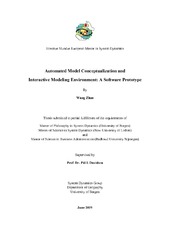Automated Model Conceptualization and Interactive Modeling Environment: A Software Prototype
Master thesis
Permanent lenke
https://hdl.handle.net/1956/20658Utgivelsesdato
2019-08-14Metadata
Vis full innførselSamlinger
- Department of Geography [634]
Sammendrag
In system dynamics modeling process, modelers retrieve information from various sources to come up with a model that is able to reproduce a problematic behavior, then based on the model, policies are designed to alleviate this problem. Aiming at facilitating or automating this process, researchers have been focusing on integrating this modeling process with technologies from computer science, data science, and artificial intelligence. Model conceptualization is a key step in this process. Sometimes it is also called ‘structure generation’. It is about coming up with model structures based on available information on the problem or the situation where the problem is manifested. A series of research projects have been focusing on automating this conceptualizing step. In the first part ‘Introduction’, the author will introduce basics of system dynamics modeling process, with a focus on the step ‘model conceptualization’ and information needed for this step. In the second part ‘Literature review’, the author will guide a tour of important researches in the past 20 years on automated model conceptualization. In the end of this part, the author will discuss their methods and information sources they used for model conceptualization. In the third part ‘A platform for interactive model conceptualization’, the author will propose a method for automated model conceptualization. The method is able to utilize information sources which have not been used in existing researches. The method has been preliminarily implemented as a demo software: A Python-based interactive modeling platform. In the fourth part ‘Experiments and results’, features of the software will be demonstrated by carrying out three case-studies step-by-step. In the last part ‘Discussions’, the author will summarize this project, discuss the innovations in this work, how these innovations could help the research of automation of model conceptualization, limitations to this work, and how the author plans to overcome these limitations in the future.
